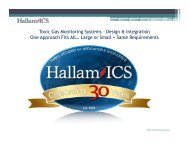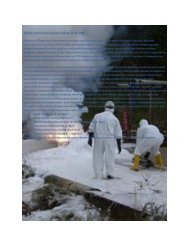Semiconductor Processing.pdf - Semiconductor Safety Association
Semiconductor Processing.pdf - Semiconductor Safety Association
Semiconductor Processing.pdf - Semiconductor Safety Association
Create successful ePaper yourself
Turn your PDF publications into a flip-book with our unique Google optimized e-Paper software.
<strong>Semiconductor</strong><br />
<strong>Processing</strong><br />
Brian Sherin
• Gordon Moore, Intel<br />
Moore’s Law<br />
• 1965, 4 yrs after the 1 st planar IC was discovered.<br />
• Predicted that the number of transistors per IC would<br />
double every 18 months.<br />
• Forecast that this trend would continue through 1975.<br />
• Through technology, Moore's Law has been maintained
Computing Power<br />
Computing Power<br />
When will computer hardware match the human brain?, Hans Moravec,<br />
http://www.transhumanist.com/volume1/moravec.htm
Computing Power / Cost<br />
Computing Power / Cost<br />
When will computer hardware match the human brain?, Hans Moravec,<br />
http://www.transhumanist.com/volume1/moravec.htm
Computer Artificial Intelligence<br />
Computer Artificial Intelligence<br />
When will computer hardware match the human brain?, Hans Moravec,<br />
http://www.transhumanist.com/volume1/moravec.htm
Health & <strong>Safety</strong> Hazards<br />
Brian Sherin
Process & Facility Hazards<br />
Hazardous<br />
Production<br />
Materials<br />
Hazardous Energy<br />
Ergonomics<br />
Man-made &<br />
Natural<br />
Emergencies<br />
Fire & Smoke
Hazardous Energies<br />
• Mechanical<br />
• Robotics<br />
• Electrical<br />
• High & Low Voltage<br />
• Chemical<br />
• Reactive materials<br />
• Radiation<br />
• Non-ionizing<br />
radiation<br />
• Thermal<br />
• Cryogenics & heat<br />
sources<br />
• Pressure<br />
• Pneumatic<br />
• Hydraulic<br />
• Vacuum
Hazardous Energy: Radiation<br />
• Ionizing radiation<br />
• Ion implantation, scanning electron microscopes<br />
• Non-ionizing radiation<br />
• Static magnetic fields (0 Hz)<br />
• Sub radio-frequency fields (1 Hz - 3 kHz)<br />
• Power frequency fields (50 or 60 Hz)<br />
• Radio-frequency fields (3 kHz - 300 GHz)<br />
• Infrared energy (700 nm - 1 mm)<br />
• Visible light (400 - 700 nm)<br />
• Ultraviolet energy (180 - 400 nm)<br />
• Lasers<br />
• Noise (CE-MD: > 75dBA)
Controls<br />
• Lockout / Tag-out Programs<br />
• Isolation devices<br />
• Interlocks<br />
• Hardware, software, firmware<br />
• Emergency Shutdown<br />
• Emergency Machine Off (EMO)<br />
• Operator Notification<br />
• Audio-visual
Controls<br />
• Administrative controls<br />
• Type 1 (de-energized) energized) through<br />
type 4 (> 30 V rms , 42.4 V peak , 60<br />
VDC, 240 VA)<br />
• Certified critical components<br />
• Guards & Enclosures<br />
• Labeling
Hazardous Production Materials<br />
(HPM)<br />
• Physical Hazard<br />
• Explosives<br />
• Compressed Gases<br />
• Flammable & Combustible Liquids<br />
• Class I-A, I<br />
I-B, I<br />
I-C, I<br />
II, III-A, and<br />
III-B<br />
• Flammable solids<br />
• Organic peroxides<br />
• Class I through V<br />
• Oxidizers<br />
• Class 1 through 4<br />
• Pyrophorics<br />
• Unstable Reactives<br />
• Class 1 through 4<br />
• Water Reactives<br />
• Class 1, 2, 3<br />
• Cryogenic<br />
• flammable or oxidizing<br />
• Health Hazard<br />
• Highly toxic or toxic<br />
materials<br />
• Radioactive<br />
materials<br />
• Corrosives<br />
• Carcinogens<br />
irritants, sensitizers,<br />
and other health<br />
hazards
HPM Controls<br />
• Building design (H-Occupancy)<br />
• Quantity dependent<br />
• Control areas (“fire barrier”)<br />
• Storage & Dispensing rooms<br />
• Separation of incompatibles<br />
• Exit & Service corridors<br />
• Ventilation / Exhaust systems<br />
• Clean-room recirculation<br />
• Sprinkler system design<br />
• Emergency Power
HPM Controls<br />
• Use & Handling<br />
• Chemical containment<br />
• Storage<br />
• Delivery<br />
• Materials of construction<br />
• Workstation ventilation<br />
• Sub-atmospheric delivery systems<br />
• Monitoring & Alarms<br />
• Gas<br />
• Liquid<br />
• Point of use treatment systems<br />
• Automatic and manual shutdowns<br />
• Process liquid heating systems<br />
• Excess flow control / restrictive flow orifices<br />
• Emergency Plans and Teams
Fire Prevention<br />
• Risk assessment must be performed<br />
• Evaluate materials of construction, regardless<br />
of quantity or application<br />
• Assess<br />
• Knobs, buttons, contactors, circuit boards, etc.<br />
• size of each component,<br />
• total quantity and distribution of components<br />
• inherent properties of the materials<br />
• Exposure to oxidizers and ignition sources
Fire Prevention<br />
• Risk Assessment: Process Chemicals<br />
• Evaluate type, concentration, state,<br />
temperature and pressure<br />
• Evaluate available flow, pressure and<br />
quantity of chemicals fed from facility<br />
• Inherent properties of chemicals (i.e.,<br />
flammability)<br />
• Exposure to oxidizers and ignition<br />
sources
Fire Prevention<br />
• Risk Assessment: Sources of Ignition<br />
• Internal sources<br />
• Electrical<br />
• Chemical (exothermic reactions)<br />
• Sudden changes in process conditions<br />
• Mechanical friction<br />
• External sources<br />
• Risk Assessment: Oxidizers<br />
• Assume oxygen is available in infinite supply to<br />
support combustion<br />
• Determine if materials of construction may act<br />
as oxidizers under normal conditions or when<br />
exposed to heat
Fire Prevention<br />
• Reduction of risk<br />
• Elimination of contributing factor(s)<br />
• Engineering control<br />
• Administrative control<br />
• Detection<br />
• Suppression<br />
• Approved for application
Ergonomics / Human Factors<br />
• Eliminate or minimize ergonomic and human<br />
factors related hazards during installation,<br />
operation, and maintenance<br />
• Awkward postures<br />
• Repetitive motions<br />
• Access space, clearances, and reaches<br />
• Lifting of heavy or bulky objects<br />
• Difficult displays and hand controls<br />
• Situations:<br />
• Manual handling<br />
• Wafer and cassette handling<br />
• Workstation design<br />
• Display locations
Process Hazard Analysis<br />
• “What If” Analysis<br />
• HazOp Study<br />
• Procedural HazOp Study<br />
• Fault Tree Analysis (FTA)<br />
• Failure Modes, Effects and Criticality<br />
Analysis (FMECA)
SEMI S10 Risk Assessment<br />
• SEMI S10-1296<br />
1296 - <strong>Safety</strong> Guideline<br />
for Risk Assessment<br />
• Provides a consistent method for<br />
assessing risk associated with any<br />
hazard<br />
• Uses severity and likelihood<br />
• Divides risk level into five categories<br />
• Critical, High, Medium, Low, Slight
SEMI S10 Risk Matrix<br />
S<br />
E<br />
V<br />
E<br />
R<br />
I<br />
T<br />
Y<br />
RISK<br />
ASSESSMENT<br />
MATRIX<br />
Catastrophic<br />
1<br />
Severe<br />
2<br />
Moderate<br />
3<br />
Minor<br />
4<br />
FREQUENT<br />
A<br />
LIKELY<br />
B<br />
LIKELIHOOD<br />
POSSIBLE<br />
C<br />
RARELY<br />
D<br />
UNLIKELY<br />
E




